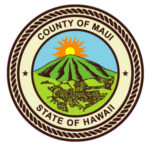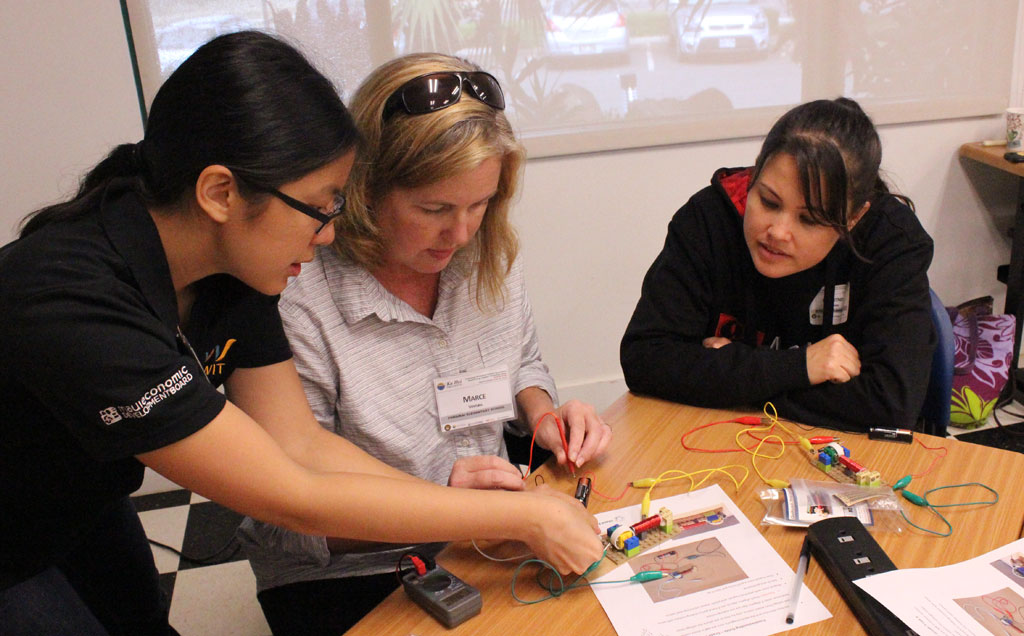
Jan 21, 2016 | Education, Environment, Sustainability

Since 2009, the Maui Economic Development Board (MEDB) Women In Technology program (WIT) has trained 459 educators through the energy science curriculum of its Island Energy Inquiry (IEI) initiative. In that time it has expanded from Maui across the state, reaching at least 49,000 students. IEI is the first energy education program designed for Hawaii teachers that combines scientific inquiry and engineering design processes with cutting-edge materials and technologies in the classroom. Teachers are using this new knowledge and hands-on activities to help middle and high school students learn about and perhaps someday solve the state’s energy concerns. “Through the IEI workshops, our MEDB team helps teachers educate for energy prosperity,” said Graham R. DeVey, WIT Project Manager. “Our hands-on, student-driven labs and activities use the natural curiosity of students to develop their skills for tomorrow’s high-tech jobs in renewable energy here in Hawaii.”
In recent Maui workshops for teachers of grades K through 5, WIT Project Assistant, Manda Tong supported the educators in an IEI electromagnetic motor lab, building the foundational concepts used in engineering wind and hydro generators. “In IEI courses, teachers learn as students do, by applying scientific skills through a hands-on approach,” Tong explained. The workshop series, focusing on photovoltaic electricity, wind energy, solar thermal energy and energy efficiency, incorporated presentations from local engineers and other industry representatives on various energy topics. Participating teachers also received hands-on kits to take back to the classroom, including miniature PV modules, a four-foot wind turbine and energy auditing equipment. WIT’s IEI Program, in partnership with Ka Hei, a Department of Education Program, also includes comprehensive energy efficiency and water conservation initiatives, sustainability measures, microgrids, science, technology, engineering and math (STEM) curriculum and community involvement.
To augment the IEI curriculum and make it more tech-relevant to teens, a companion Clean-Energy Hawaii STEM iPad app has been created by NSC Partners LLC, a Maui-based software developer. The app is available at the iTunes store and features Hawaii-specific clean energy content that can be adapted to support innovative energy science education in any community throughout the world.
Maui Economic Development Board’s Women In Technology Island Energy Inquiry Program (IEI) launched its elementary school curriculum this past fall, training 35 teachers of grades K through 5 to teach clean energy modules. The IEI program helps build student competency towards energy prosperity for Hawaii’s future.
Manda Tong, MEDB Project Assistant
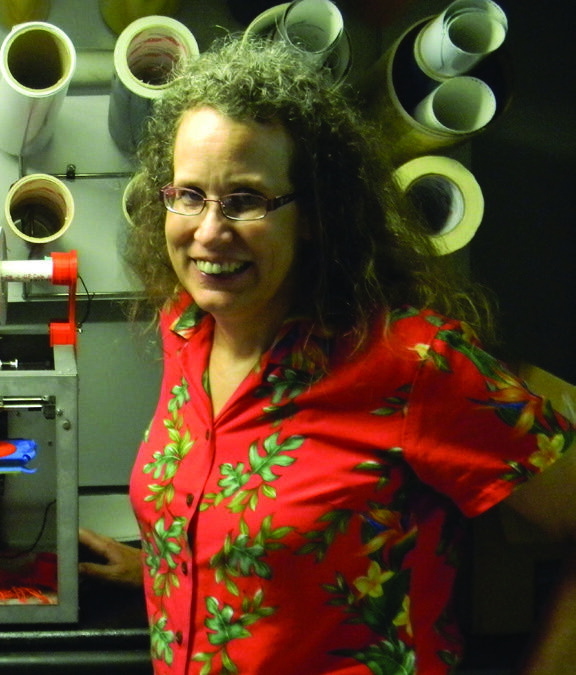
Jan 14, 2016 | Small Business
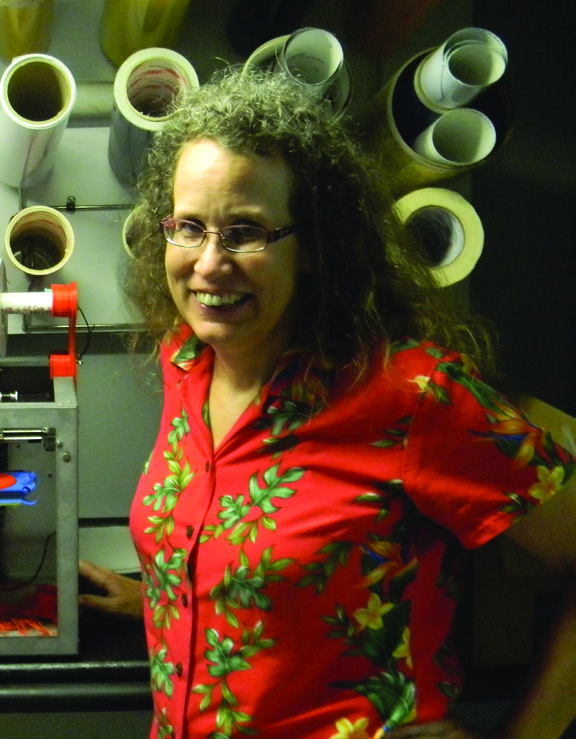 Maui Makers, a 501(c)(3) nonprofit, is based on the belief that by working together we can prove that Hawai’i’s future is really what we “make of it.” Organized in 2010 by Haiku resident, Jerry Isdale, this unique group provides the venue, knowledge, and atmosphere to help people create their dreams. “Through educational outreach in the community, Maui Makers has inspired community members to be makers of things, not just consumers of things,” said Isdale. “There are very talented people on Maui. Naturally, these people need a dynamic workspace with access to collaboration and encouragement from others. In addition, participants have access to 21st century tools, fabrication processes and materials otherwise unaffordable or unattainable.”
Maui Makers, a 501(c)(3) nonprofit, is based on the belief that by working together we can prove that Hawai’i’s future is really what we “make of it.” Organized in 2010 by Haiku resident, Jerry Isdale, this unique group provides the venue, knowledge, and atmosphere to help people create their dreams. “Through educational outreach in the community, Maui Makers has inspired community members to be makers of things, not just consumers of things,” said Isdale. “There are very talented people on Maui. Naturally, these people need a dynamic workspace with access to collaboration and encouragement from others. In addition, participants have access to 21st century tools, fabrication processes and materials otherwise unaffordable or unattainable.”
Maui Makers holds public meetings, classes and a variety of workshops to create and construct things. They establish focus groups centered on various technologies and interests. The Arduino Innovation Group was the first of these to gain a following. Arduino is the name of an open-source electronics platform and the software used to program it. “It is designed to make electronics more accessible to artists, designers, hobbyists and anyone interested in creating interactive objects or environments,” said Workshop Instructor Laura Ulibarri. “My interest and connection to Maui Makers is through using open-source software and hardware to build a culture of innovation on Maui. There is a huge opportunity to start a company, get a business up and rolling and learn from others.” Makers encourages people to become entrepreneurs and to pursue careers in design, advanced manufacturing, or the related fields of science, technology, engineering and mathematics (STEM).
Maui Makers also offers engineering design projects for teachers and students as well as community members. They often partner with Maui Economic Development Board (MEDB) to provide resources and support for improving STEM education in Maui County and beyond. “Like MEDB, we want to provide STEM learning opportunities that contribute to Hawai’i’s future viability,” Ulibarri said.
I think we’re on the brink of another revolution, this time favoring craftsmen and makers.
Laura Ulibarri, Maui Makers Workshop Instructor
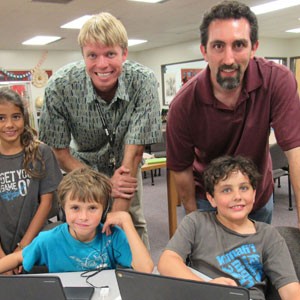
Jan 6, 2016 | Education, Innovation, Stemworks

In celebration of Computer Science Education Week in December, Hour of Code, a nationwide campaign featuring free tutorials designed to get students interested in computer science, was held at Kamaliʻi Elementary School in Kihei. Maui Economic Development Board’s Women in Technology Project (WIT) was a sponsor for the one-hour introduction. Children and adults were taught basic concepts of computer programming that offered them learning tools needed to create and communicate new ideas. “Hour of Code is an international movement to promote computer science education and call awareness to exciting 21st century career paths,” said Peter Hansen, Kamaliʻi School computer teacher. “Learning to code helps nurture problem-solving skills, logic and originality. One hour is enough to learn that computer science is fun and creative, that it is accessible for all ages, for everyone.”
The tutorials teach a computer language called JavaScript which is designed to perform a certain task. By dragging and placing blocks of code in the computer program, the code tells the computer what to display on the screen. A JavaScript function is executed when something invokes it; hence students learn that all they see and do begins with lines of computer code. “I hope that through this event Kamaliʻi School’s technology program will receive some attention and parents and community members will begin to understand the importance of having computer science education for all students, even at the elementary level,” explained Hansen. Lucy Dryhurst, Kamaliʻi 5th grader said, “I learned through Hour of Code that by following directions on a game with a lot of thinking steps, I can write code. I like doing it a lot. It is fun and creative!”
“WIT is an extraordinary program,” Hansen noted. “They offered monetary support that made it possible to provide food and drinks for Hour of Code, not to mention donating the prizes and connecting us with volunteers.” In addition to this event, WIT provides professional educational opportunities for teachers and workshops for students, developing Maui’s future workforce.
On behalf of myself and Kamali’i School thank you very much, WIT, for your continuing support for Maui County teachers and students.
Peter Hansen, Kamaliʻi School Computer Teacher
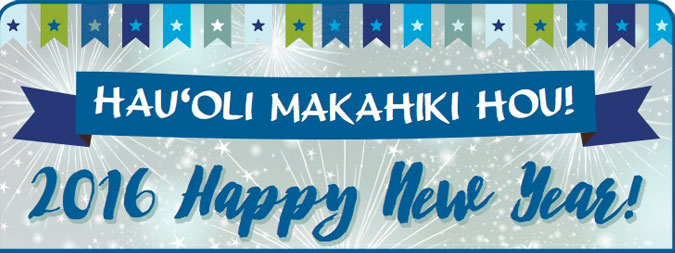
Dec 30, 2015 | Community
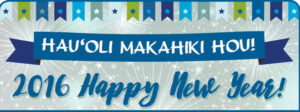
The Hawaiian Islands, home to a culturally and ethnically diverse population, are about to celebrate one of the most fun-filled festivals of the year. Many are laying elaborate plans to usher in the New Year with different customs and foods from different cultures. The common aim is to bring good luck in the transition from old to new, celebrated in what seems to be as many ways as possible.
Native Hawaiians celebrate Makahiki traditions of games and sports, and observing religious ceremonies. In ancient times, the Makahiki season extended through the winter months. The widespread use of firecrackers is one New Year’s custom that everyone seems to enjoy. The tradition, which Chinese immigrants brought to the islands in the 19th century, was originally meant to scare off evil spirits. Now, of course, it’s for wholehearted enjoyment. The New Year is also a time to share and sample food from other cultures. For example, Portuguese prepare bean soup, Filipinos cook up pork adobo (marinated, seasoned and simmered meat) and the Chinese make different kinds of dumplings and noodles, symbolizing longevity. Another popular New Year’s dish is mochi, a type of Japanese rice cake made with sticky rice that is repeatedly pounded in ceremonial tradition. The round shape of the mochi, and its glutinous texture, represent family harmony and cohesiveness. A Japanese tradition of eating sashimi on December 31 finds it roots in local Japanese culture, with the fish representing prosperity for the coming year. While other cultures around the globe have their own New Year’s culinary idiosyncrasies and customs, most indulge in the universal symbol of good fortune — a toast at midnight and a verse of “Auld Lang Syne.” As the New Year approaches, the Maui Economic Development Board, MEDB, Staff would like to be among the first to wish you “Hau’oli Makahiki Hou.” Happy New Year!

Dec 24, 2015 | Community
 The holiday season marks the time of year when we take stock and look ahead, often through making resolutions. Five notable holiday resolutions to live by have been compiled by poet and writer Julie-Anne Ford. Among her recommendations:
The holiday season marks the time of year when we take stock and look ahead, often through making resolutions. Five notable holiday resolutions to live by have been compiled by poet and writer Julie-Anne Ford. Among her recommendations:
Learn to Laugh
Celebrate the simple joy of living and open your heart to all life holds for you.
Learn to Listen
Take time to slow down and be still.
Learn to Let Go
Forgive failures and resolve regrets.
Learn to Love
Remember love is not just something you feel, but the things you do.
Learn to Live
Search for your purpose, seek out your passions.
In the generous spirit of the holidays, MEDB wishes everyone a life lifted and lived in aloha. – MEDB staff







